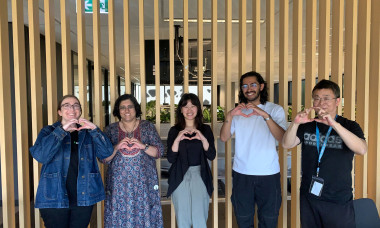Are your students safe and well? The time to be sure is now
Student safety and wellbeing is becoming a first-order consideration for educators. We asked Sonder’s Robert Chasse what educators need to know in 2022 (and how tech can help).
Student safety and wellbeing support has not always been at the top of the to-do list in tertiary education. Whilst security and support services are put in place with the best of intentions, they can be seen as a secondary consideration, rather than embraced as being at the centre of the student offer.
This changed as COVID-19 pushed health, safety and wellbeing services to front of mind for educators.
Whether it was the remote learning explosion, or returning to campuses during a pandemic, physical and mental wellbeing challenges have been a part of everyday operations. Meanwhile, the recent National Student Safety Survey has highlighted the prevalence of risks to safety such as sexual assault and harassment.
There is a rising realisation that educators will need to do more to meet their duty of care to students.
Sonder is a health-tech company providing 24/7 wellbeing and safety support services for educational institutions and their students (as well as corporate and government workforces). Education Partnerships Manager, Robert Chasse, says Sonder’s experience suggests educators should be considering elevating safety and wellbeing services.
“It’s not that educators are not taking this seriously or don’t have the best intentions. Take VET as an example - it is a complex landscape, with multiple campuses, different tenures of study, there is remote learning – it’s difficult to take action to provide a one-size-fits-all answer to safety and wellbeing for students,” Robert says.
“With that said, now really is the time to tackle this because the longer-term effects of COVID-19 have only begun to rear their ugly head. Without holistic wellbeing support, it’s hard to know what it will look like for people in six months or a year.”
Student health and safety concerns are becoming more complex
Sonder is a mobile app-based service that allows student and staff users to access to a range of safety and wellbeing features. For example, it gives users access to 24/7 safety, medical, and mental health experts, via chat, text, phone and video call. The service is also backed up by an in-person critical incident responder network for in-person emergency support across Australia and New Zealand.
With over 400,000 users, the company has a good vantage point to view emerging trends. The picture? Increasing complexity.
“What we are finding is that over half of the cases we support now have more than one issue. It’s not just about safety, or mental health, or medical. It’s about multiple issues or stressors, which is really important for educators to understand. Whether we’re talking about employees, leaders, or students. It’s complicated.”
For example, Robert says 51% of cases that come in are initially medical. Thanks to a business model that allows Sonder to take as long as required to support each case, taking time to unpack the medical issue in a large proportion of cases often uncovers other underlying issues, like a wellbeing or mental health issue.
The pandemic has given rise to at least some of this complexity – and this is likely to continue in future.
“Many of our earlier COVID-specific requests were about COVID exposures, travel restrictions, locating testing sites, or isolation requirements. But COVID has created other types of complexity. It has triggered dormant mental health issues, increasing things such as stress, anxiety and depression,” Robert says.
Part of this complexity comes from the changed circumstances in which people are now living, working and studying. “There’s been a blurring of the lines between study, work, and personal spaces. This means an increasing overlap between work-related issues and personal issues.”
5 student support service model elements that boost human-centricity
How can educators get better at meeting an increasingly complex picture of student safety and wellness?
Robert, who has previously managed student services in an Australian university, says educators have the right intentions when it comes to student support. After all, mentally and physically well students are more likely to produce positive results academically, and be more engaged in university life – both of which are good for their institutions. Institutions do want to do the right thing by students.
Often though, there are things that get in the way of being able to do this effectively. “ The real challenge now for educators is providing services that are much more student-centric. This means simplifying the access in help-seeking, by decluttering the existing support ecosystem and streamlining the experience for students” he says.
There are a lot of ways to increase student-centricity. Here are some examples from the Sonder service model:
1. A single point of entry
Disparate or siloed services create barriers for students seeking help. It means students often have to self-diagnose their own problem and then do the work of finding out if help exists and how and when to get it. This can be even more difficult where services are not in their native language or when there are multiple issues.
When students use Sonder, they come through a single-entry point, and are triaged and connected with the range of services they need as individuals, no matter what their health and safety issue. Everything is available in one place, including streamlined referral pathways to access additional resources.
2. Access via mobile app
Most existing safety and wellbeing services are set up in a way that students need to call a phone number. But this is not how people intuitively want to access services in the flow of life and learning. For example, a huge 91% of Sonder’s help requests come through in-app chat and safety features.
“It’s really about convenience and time. Chat is a private and immediate method of communication, allowing people to pop in and out of the conversation.”
3. Access whenever you like
Part of the problem with existing safety and wellbeing setups is that students often have to contact a provider during work hours, typically 9am to 5pm. In addition, they may need to schedule a time to visit a service during those hours. But Sonder data shows more than half of the cases it receives come in out of business hours.
“That is when issues are happening or when people have time to deal with it, when they are not in class or at work. It is a personal wellbeing and safety tool to be used anytime and anywhere for any issue.”
4. Upstream health support
Part of the student-centric evolution is to provide stronger early intervention and proactive support for issues such as mental health. This raises the question of how you reach people who are currently mentally and physically well, so that if the time comes, they know where to go and trust in the support they are provided.
Sonder makes use of proactive, personalised messaging with relevant information linked to the student lifecycle, such as the academic calendar and exam times. Things like resources on how to manage stress (or wellbeing assessment tools) help to build trust early and open the door to people requesting help.
“Over 70% of our students engage in Sonder’s in-app preventative content and proactive messaging” Robert says. “Students have the opportunity to engage with content relevant to and helpful for them. This model support students on their wellbeing journey from building resilience, to encouraging early intervention to providing 24/7 multilingual on-demand support.”
5. Service scalability
Sonder’s experience is that educational institutions are fantastic at responding to and providing ongoing treatment to a particular student if they need it. However, there can be problems for these providers in providing support for larger numbers of students, revealing issues in the scalability of personalised support.
“It’s difficult for educational providers to offer a 24/7, holistic model of care and personalised in-person support from a capped number of staff members. Should there be a large scale event impacting a high volume of students requiring specialised care, the current infrastructure in place makes it very difficult to support the students as individuals with a variety of needs.”
Towards a more holistic future for student safety and wellness support
The future of student safety and wellness is about creating human-centric services, Sonder argues.
“The traditional ways people engage in help-seeking have changed. We now need to think about putting the student at the centre and providing holistic support. Students want and need a clear health-seeking pathway, where they can literally say, ‘I have a problem and I don’t know what it is, help me and don’t make me search for it’.”
This will mean going beyond a purely reactive or symptom-based approach to care. Rather, it will be about providing upstream support for those who may not yet be in a high acuity care situation.
“Just because someone is not seeking help, we can’t presume they are well.”
That’s even more so after COVID-19, which may be the tertiary education sector’s wake-up call to embrace wellness.
“What we are seeing at Sonder is the convergence of technology and specialised human support for the whole person, which puts the human at the centre, and removes the traditional barriers to help-seeking and better mental and physical health.”
Want to find out more about how Sonder is helping providers across higher and vocational education safeguard student safety and wellness with technology? Visit the Sonder website here.






